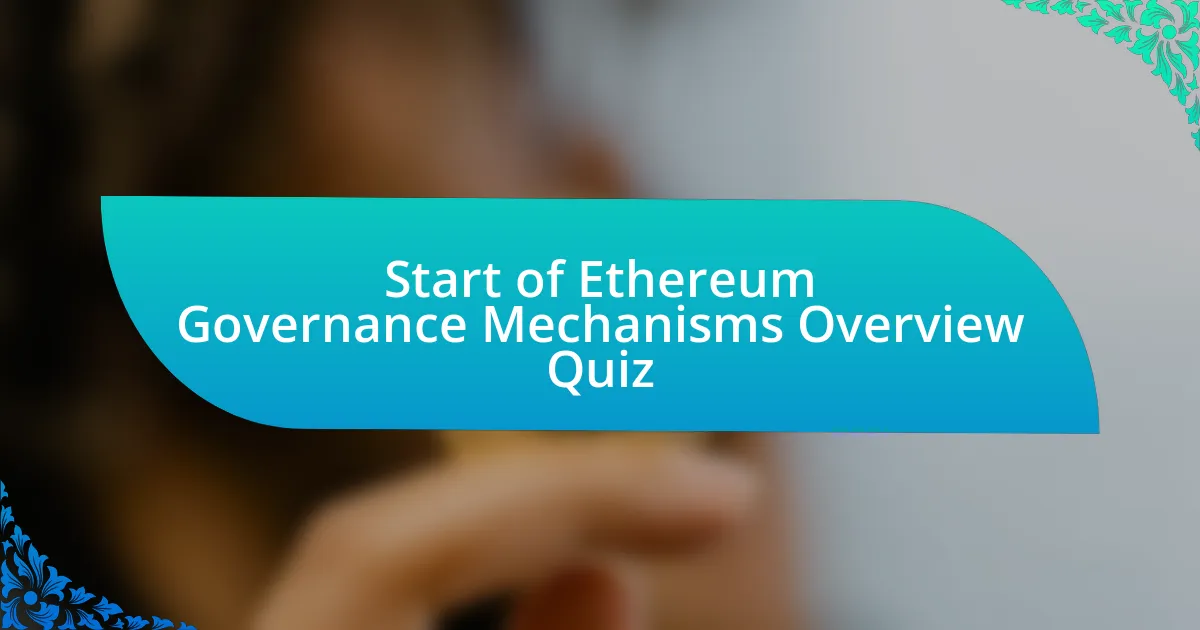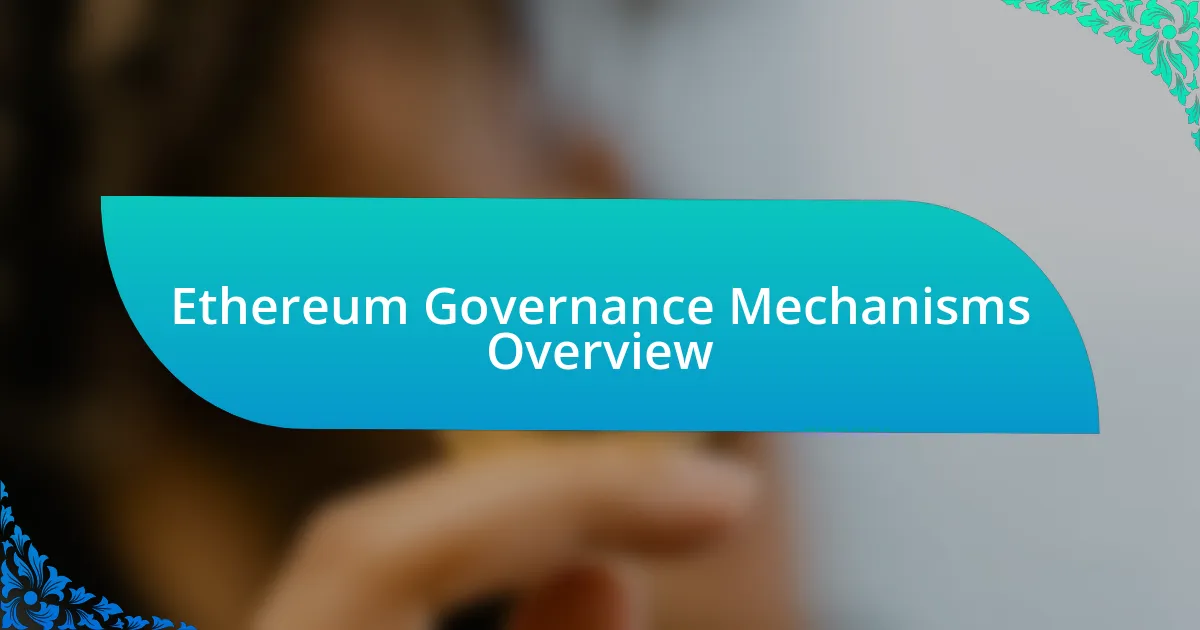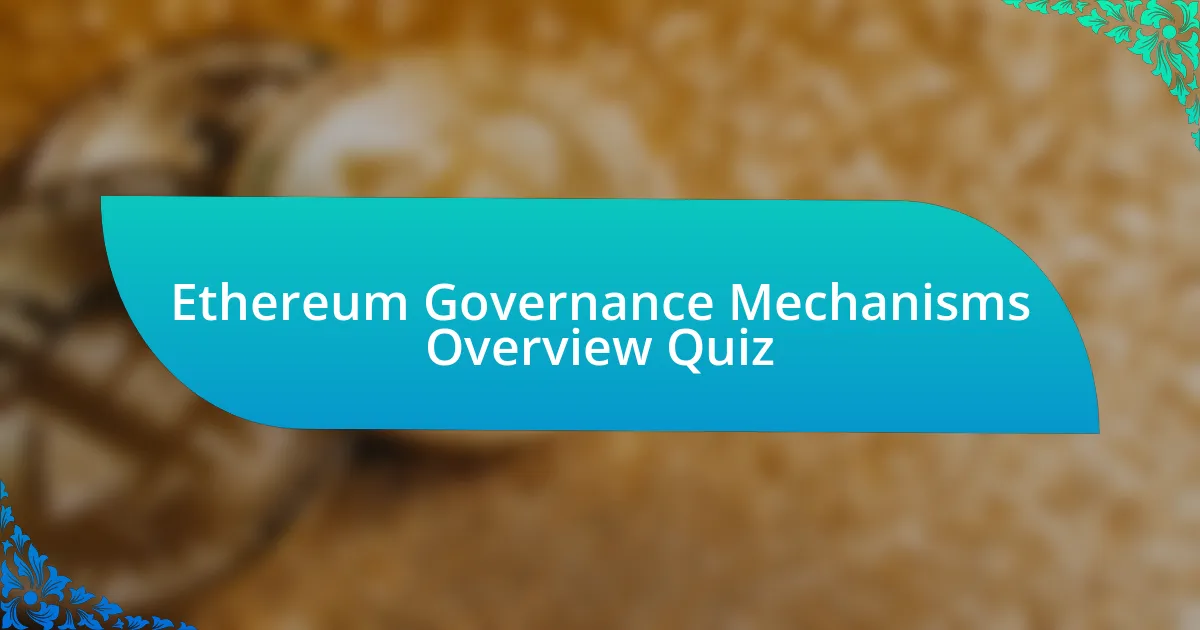
Start of Ethereum Governance Mechanisms Overview Quiz
1. What is the guiding principle of Ethereum governance?
- Credible neutrality
- Market dominance
- Exclusive membership
- Centralized authority
2. Who is involved in the Ethereum governance process?
- Ether holders, DApps users, developers, and validators.
- Just the miners in the network.
- Only the Ethereum Foundation members.
- Only core developers of Ethereum.
3. What is on-chain governance in Ethereum?
- On-chain governance means all decisions are made without any user input.
- On-chain governance requires only the Ethereum Foundation to approve changes.
- On-chain governance involves users casting votes directly on the blockchain for proposals.
- On-chain governance entails private discussions among core developers to make decisions.
4. What is off-chain governance in Ethereum?
- Off-chain governance is a form of centralized decision-making controlled by one entity.
- Off-chain governance involves only developers making decisions without community input.
- Off-chain governance involves decision-making through informal processes on platforms like Discord and GitHub.
- Off-chain governance requires users to cast votes directly on the blockchain for proposals.
5. What is an Ethereum Improvement Proposal (EIP)?
- An EIP is an algorithm for mining Ethereum coins.
- An EIP is a financial report on Ethereum`s market performance.
- An EIP is a document proposing changes or additions to the Ethereum protocol.
- An EIP is a trading strategy for Ethereum investors.
6. How are disagreements handled in Ethereum governance?
- Disagreements are ignored until a majority supports a decision.
- Disagreements are settled by public voting on social media.
- Disagreements are handled through community discussion and consensus among stakeholders.
- Disagreements are resolved by a central authority making the final call.
7. Who proposes changes to the Ethereum protocol?
- Anyone in the community can propose changes through EIPs.
- Only validators can propose changes.
- Only the Ethereum Foundation can propose changes.
- Only core developers can propose changes.
8. Who decides which EIPs are implemented?
- The community, including core developers, node operators, validators, and users, decides through consensus.
- Only the core developers decide on the implementation of EIPs.
- The consensus mechanism alone decides which EIPs are implemented.
- The Ethereum Foundation decides which EIPs are implemented.
9. What is the role of validators in Ethereum governance?
- Validators propose new blocks and attest to their validity, ensuring the integrity of the blockchain.
- Validators direct user funds to different DeFi platforms for profit.
- Validators develop new cryptocurrencies to enhance the Ethereum network.
- Validators create smart contracts and execute transactions on the blockchain.
10. How do validators earn rewards in Ethereum?
- Validators earn rewards by hosting community events.
- Validators earn rewards by creating new blocks and participating in the validation process.
- Validators earn rewards by trading tokens on exchanges.
- Validators earn rewards by developing smart contracts for users.
11. What happens to dishonest validators in Ethereum?
- Dishonest validators are rewarded with additional ETH for their actions.
- Dishonest validators are punished by having their staked ETH burned and removed from the network.
- Dishonest validators face no consequences and can continue validating.
- Dishonest validators are promoted to higher ranks within the network.
12. What is the consensus mechanism used by Ethereum?
- Proof-of-work
- Proof-of-stake
- Byzantine fault tolerance
- Delegated proof-of-stake
13. How does the proof-of-stake mechanism work in Ethereum?
- Validators need 128 ETH to participate in the proof-of-stake mechanism on Ethereum.
- Validators use a random lottery to earn validation rights based on their transaction fees.
- Validators must compete in a mining race to create new blocks and validate transactions.
- Validators stake 32 ETH to activate their validation ability, and the finalization protocol is Casper-FFG.
14. What is the purpose of Ethereum Improvement Proposals (EIPs)?
- EIPs serve as legal documents for transactions on the Ethereum network.
- EIPs detail changes or additions to the Ethereum protocol and undergo extensive community review.
- EIPs are used to create marketing strategies for Ethereum applications.
- EIPs are proposals for new cryptocurrencies unrelated to Ethereum.
15. Where are EIPs typically discussed?
- Ethereum Magicians
- Telegram
16. What is the significance of credible neutrality in Ethereum governance?
- Credible neutrality allows for rapid and unchecked governance changes.
- Credible neutrality ensures that governance mechanisms do not discriminate for or against specific people.
- Credible neutrality helps ensure only developers have decision-making power.
- Credible neutrality is designed to prioritize large stakeholders in governance decisions.
17. How does Ethereum’s governance model ensure fairness?
- By allowing only developers to propose changes.
- By involving a diverse group of stakeholders in decision-making.
- By ensuring only large holders can vote on proposals.
- By limiting discussions to private meetings.
18. What is the role of the Ethereum Foundation in governance?
- The Ethereum Foundation decides on all EIPs and their implementation.
- The Ethereum Foundation exclusively controls all validator activities on the network.
- The Ethereum Foundation holds all governance votes for the community.
- The Ethereum Foundation does not directly govern but supports the development and promotion of the platform.
19. How does Ethereum handle large ETH whale holders in governance?
- Ethereum prohibits large ETH whale holders from voting on governance proposals altogether.
- Ethereum ensures that governance decisions are not influenced by large ETH whale holders by using off-chain governance processes.
- Ethereum limits the voting rights of small holders to safeguard against large ETH whale influence.
- Ethereum gives preferential voting power to large ETH whale holders to streamline decision-making.
20. What are the benefits of off-chain governance in Ethereum?
- Off-chain governance limits participation to only core developers.
- Off-chain governance ensures flexibility and reduces the risk of manipulation.
- Off-chain governance requires all decisions to be logged on the blockchain.
- Off-chain governance mandates formal voting procedures for all changes.
21. What are the limitations of off-chain governance in Ethereum?
- Off-chain governance can be difficult to audit and evaluate objectively due to its opaque and subjective nature.
- Off-chain governance relies exclusively on a single authority for decision-making.
- Off-chain governance guarantees immediate consensus among all participants.
- Off-chain governance is primarily conducted through formal voting on the blockchain.
22. How does Ethereum’s governance model foster community participation?
- Ethereum’s governance model requires approval from a centralized authority for participation.
- Ethereum’s governance model fosters community participation by allowing anyone to propose EIPs and participate in discussions.
- Ethereum’s governance model only allows major investors to make decisions.
- Ethereum’s governance model limits participation to core developers and validators only.
23. What is the outcome of disagreements in Ethereum governance?
- Disagreements are resolved through binding arbitration and cannot be disputed.
- Disagreements are ignored and have no impact on the governance process whatsoever.
- Disagreements can lead to slower decision-making and potential splits in the community, as seen in the `The DAO Hack` incident.
- Disagreements result in immediate implementation of opposing proposals without debate.
24. How does Ethereum’s governance model ensure decentralized decision-making?
- Only large ETH holders can influence decisions in Ethereum’s governance model due to their significant stake.
- Ethereum’s governance model ensures decentralized decision-making by involving core developers, node operators, validators, and users in the decision-making process.
- Ethereum’s governance relies solely on the Ethereum Foundation to make all decisions for the network.
- Decisions in Ethereum’s governance are made exclusively through automated algorithms that do not involve community input.
25. What is the significance of Ethereum Improvement Proposals (EIPs) in governance?
- EIPs facilitate community involvement in the development process.
- EIPs restrict proposals to only major stakeholders.
- EIPs centralize decision-making among core developers.
- EIPs eliminate the need for community discussions.
26. How are EIPs reviewed and implemented?
- EIPs are published without community input or review.
- EIPs are ignored if they do not gain immediate popularity.
- EIPs undergo extensive community review and discussion before being implemented.
- EIPs are automatically implemented once proposed by developers.
27. What is the primary mechanism for governance in Ethereum?
- Ethereum Improvement Proposals (EIPs)
- Smart contracts
- Decentralized applications (DApps)
- Centralized exchanges
28. How does Ethereum’s governance model handle conflicts of interest?
- Ethereum’s governance model ignores conflicts of interest by allowing anyone to make decisions freely.
- Ethereum’s governance model resolves conflicts of interest by prioritizing large ETH holders in discussions.
- Ethereum’s governance model handles conflicts of interest by segregating user groups and limiting participation.
- Ethereum’s governance model handles conflicts of interest by ensuring that all stakeholders have equal incentives to contribute to the protocol development.
29. What is the role of node operators in Ethereum governance?
- Node operators act as validators for smart contract creation and execution.
- Node operators create new cryptocurrencies from their transactions.
- Node operators exclusively manage the Ethereum Foundation`s governance activities.
- Node operators propagate or reject blocks and transactions, helping to maintain blockchain integrity.
30. How does Ethereum’s governance model ensure transparency?
- Ethereum ensures transparency through a single centralized authority making decisions.
- Transparency in Ethereum is guaranteed by random selection of stakeholders for proposals.
- The model achieves transparency by using private meetings to discuss governance issues.
- Ethereum’s governance model ensures transparency by involving a diverse group of stakeholders in decision-making.

Quiz Successfully Completed!
Congratulations on completing the quiz on Ethereum Governance Mechanisms! We hope you found the questions challenging and informative. This quiz offered insights into how decisions are made within the Ethereum ecosystem. You’ve likely gained a better understanding of the various governance structures and the role they play in the network’s development and sustainability.
Throughout the quiz, you may have learned about key concepts such as on-chain governance, off-chain governance, and the impact of community proposals. Exploring these mechanisms can enhance your grasp of how Ethereum continues to evolve. This knowledge is crucial for anyone interested in blockchain technology and decentralized governance.
If you’re eager to dive deeper, we invite you to explore the next section on this page. There, you’ll find more detailed information on Ethereum Governance Mechanisms. Expanding your knowledge on this topic will strengthen your understanding of how Ethereum operates and adapts. Happy learning!

Ethereum Governance Mechanisms Overview
Overview of Ethereum Governance
Ethereum governance encompasses the processes and structures that guide decision-making within the Ethereum network. It involves contributors, users, and stakeholders who influence protocol changes and improvements. The governance model includes on-chain adjustments, off-chain discussions, and formalized procedures for proposals. Governance is essential as it ensures the protocol evolves in response to user needs and technological advancements.
On-Chain Governance Mechanisms
On-chain governance in Ethereum refers to decision-making processes embedded within the blockchain. This includes mechanisms like EIPs (Ethereum Improvement Proposals) that allow community members to propose changes. EIPs are subject to community review and consensus before implementation. Such structures enable systematic discussions around any proposed adjustments to the protocol itself.
Off-Chain Governance Practices
Off-chain governance practices occur outside the blockchain but influence decisions significantly. These practices include community forums, social media discussions, and developer meetings. They allow stakeholders to engage in dialogue about proposals and suggest changes without tying them directly to blockchain transactions. This informal structure encourages broader participation in governance discussions.
Role of Ethereum Improvement Proposals (EIPs)
Ethereum Improvement Proposals (EIPs) serve as formal documents providing information to the Ethereum community regarding potential changes. Each EIP outlines a proposed enhancement, detailing its purpose and implementation strategy. The community reviews these proposals, discussing their merits before deciding on adoption. This ensures that changes undergo thorough evaluation prior to becoming part of Ethereum’s codebase.
Consensus Mechanisms and Their Impact on Governance
Consensus mechanisms, particularly Proof of Stake (PoS) after Ethereum 2.0, significantly alter governance dynamics. They determine how transactions are validated and affect decision-making processes by influencing validator participation. In PoS, stakeholders must have a vested interest in proposed changes, as their economic stakes are tied to the network’s success. This alignment fosters a governance structure that encourages responsible participation in protocol evolution.
What are Ethereum governance mechanisms?
Ethereum governance mechanisms are processes and structures that enable stakeholders to make decisions about the protocol’s development and future direction. These mechanisms include on-chain governance, off-chain governance, community proposals, and developer consensus, allowing community members to propose, debate, and implement changes. The Ethereum Improvement Proposal (EIP) process exemplifies this, as anyone can submit an EIP for consideration, impacting protocol upgrades.
How do Ethereum governance mechanisms function?
Ethereum governance mechanisms function by allowing various stakeholders, including developers, miners, and users, to participate in the decision-making process. Proposals for changes are typically created as EIPs, which go through discussions, reviews, and potential acceptance or rejection based on community and developer input. This decentralized process aims to incorporate diverse viewpoints while reaching consensus on upgrades or alterations needed in the network.
Where can stakeholders participate in Ethereum governance?
Stakeholders can participate in Ethereum governance primarily through forums, social media, and GitHub repositories. Platforms such as the Ethereum Magicians forum and various Discord channels facilitate discussions around EIPs and governance issues. Additionally, stakeholder participation occurs in off-chain governance platforms, where community votes and discussions impact decision-making processes directly.
When do Ethereum governance processes occur?
Ethereum governance processes occur continuously, driven by the need for protocol updates, improvements, or responses to community challenges. Major governance decisions, such as network upgrades or hard forks, are typically announced in advance and involve extensive discussions and voting. Specific timeline milestones often align with the Ethereum development schedule, influenced by the urgency of proposed changes or community consensus.
Who is involved in Ethereum governance?
Participants in Ethereum governance include core developers, miners, node operators, and end-users. Each group plays a crucial role in the decision-making process. Core developers propose technical changes, miners and node operators maintain the network and validate updates, while users provide feedback and support for proposals, ensuring that diverse perspectives are represented in governance decisions.

